View in other NatureServe Network Field Guides
NatureServe
Montana
Utah
Wyoming
Idaho
Wisconsin
British Columbia
South Carolina
Yukon
California
New York
Mendocino Peatmoss - Sphagnum mendocinum
General Description
Plants: Growing in crowded mats (Malcolm & Malcolm 2009), chartreuse, or green with pale brown tones, the end buds swollen (FNA 2007).
Stems and Stem Leaves: Stems chartreuse. Stem leaves usually flattened to the stem, 1.2-1.5 mm in length, widely oblong-deltoid; apex blunt (FNA 2007).
Branches and Branch Leaves: Branches green, frequently 5-ranked, dimorphic, the spreading branches coarser and broader than the drooping (pendent) ones, with 2-3 drooping and 2 spreading branches in each cluster. Branch leaves lightly appressed and overlapping, egg- to lance-shaped, 2-3.5 mm in length, margins smooth; straight; plane, the edges wavy, and the apex folded back and downward when dry (FNA 2007).
Stem and Stem Leaf Cells: Stem outermost cortex consisting of 1-2 tiers of somewhat inflated cells with thin walls that are without ornaments, the exposed layer without pores. Hyaline cells of the stem leaves thin, typically lacking partitions, without pores and fibrils near the apex on the convex leaf surface, lacking fibrils but with variable pores along the cell margins on the distal concave leaf surface (FNA 2007).
Branch and Branch Leaf Cells: Branch stems enveloped in 1 layer of cortical cells having evident necks and lacking fibrils. Hyaline cells of the branch leaves with many pores, ringed and unringed, along the margins of the concave leaf surface, ca 20-27 pores per cell in the lower part of the leaf, 5-12 pores per cell in the upper portion of the leaf, the convex leaf surface with 14-21 pores per cell below and 5-15 above, mostly without a ring; green cells in X-section deltoid or trapezoidal in shape, exposed on both surfaces, but only slightly so on the concave leaf surface, the exposed walls not of great depth (FNA 2007).
Range Comments
Known only in North America.
AK, BC s to CA, ID and MT (FNA 2007). In Montana: Flathead and Missoula Counties (Elliott 2016).
Observations in Montana Natural Heritage Program Database
Number of Observations: 8
(Click on the following maps and charts to see full sized version)
Map Help and Descriptions
Relative Density
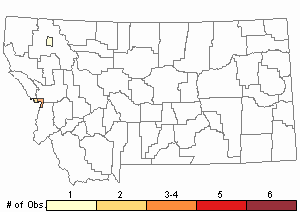
Recency
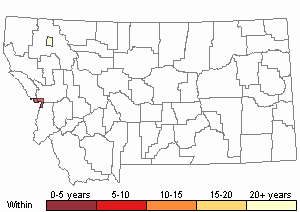
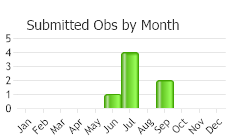
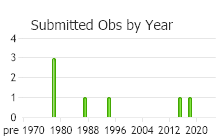
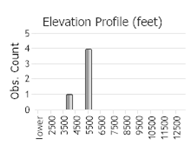 (Observations spanning multiple months or years are excluded from time charts)
(Observations spanning multiple months or years are excluded from time charts)
Habitat
Wet soil and peat (Elliott 2016), under or floating on water with low mineral content, wet hollows in coniferous and Alnus swamps, elevated bogs, drainage channels. Elevation: Low to medium (FNA 2007).
Reproductive Characteristics
Dioicous. Sporophytes not common. Capsule under 2 mm in length and with few pseudostomata (FNA 2007).
Stewardship Responsibility
References
- Literature Cited AboveLegend:
 View Online Publication
View Online Publication Elliott, J.C. and A.K. Pipp. 2018. A Checklist of Montana Mosses (1880-2018). Updated 3 January, 2020. Montana Natural Heritage Program, Helena, Montana. 73 pp.
Elliott, J.C. and A.K. Pipp. 2018. A Checklist of Montana Mosses (1880-2018). Updated 3 January, 2020. Montana Natural Heritage Program, Helena, Montana. 73 pp. Flora of North America Editorial Committee, eds. 2007. Flora of North America North of Mexico. Volume 27. Bryophytes: Mosses, Part 1. Oxford University Press, Inc., NY. xxi + 713 pp.
Flora of North America Editorial Committee, eds. 2007. Flora of North America North of Mexico. Volume 27. Bryophytes: Mosses, Part 1. Oxford University Press, Inc., NY. xxi + 713 pp. Malcolm, B., N. Malcolm, J. Shevock, and D. Norris. 2009. California Mosses. Nelson, New Zealand: Micro-Optics Press. 430 pp.
Malcolm, B., N. Malcolm, J. Shevock, and D. Norris. 2009. California Mosses. Nelson, New Zealand: Micro-Optics Press. 430 pp.
- Additional ReferencesLegend:
 View Online Publication
View Online Publication
Do you know of a citation we're missing? Elliot, J. C. 1993. Second checklist of Montana mosses. Unpublished report. U.S. Forest Service, Region 1. Missoula, MT. 45 pp.
Elliot, J. C. 1993. Second checklist of Montana mosses. Unpublished report. U.S. Forest Service, Region 1. Missoula, MT. 45 pp. Lawton, E. 1971. Keys for the Identification of the Mosses on the Pacific Northwest. Reprinted from 'Moss Flora of the Pacific Northwest'. Published as Supplement No. 2 of the Journal of the Hattori Botanical Laboratory. Nichinan, Miyazaki, Japan. 66 pp.
Lawton, E. 1971. Keys for the Identification of the Mosses on the Pacific Northwest. Reprinted from 'Moss Flora of the Pacific Northwest'. Published as Supplement No. 2 of the Journal of the Hattori Botanical Laboratory. Nichinan, Miyazaki, Japan. 66 pp. Lawton, E. 1971. Moss Flora of the Pacific Northwest. Hattori Botanical Laboratory. Japan: Yamabuki-cho, Shinjuku-ku, Tokyo. 362 pages plus appendices.
Lawton, E. 1971. Moss Flora of the Pacific Northwest. Hattori Botanical Laboratory. Japan: Yamabuki-cho, Shinjuku-ku, Tokyo. 362 pages plus appendices.
- Web Search Engines for Articles on "Mendocino Peatmoss"





